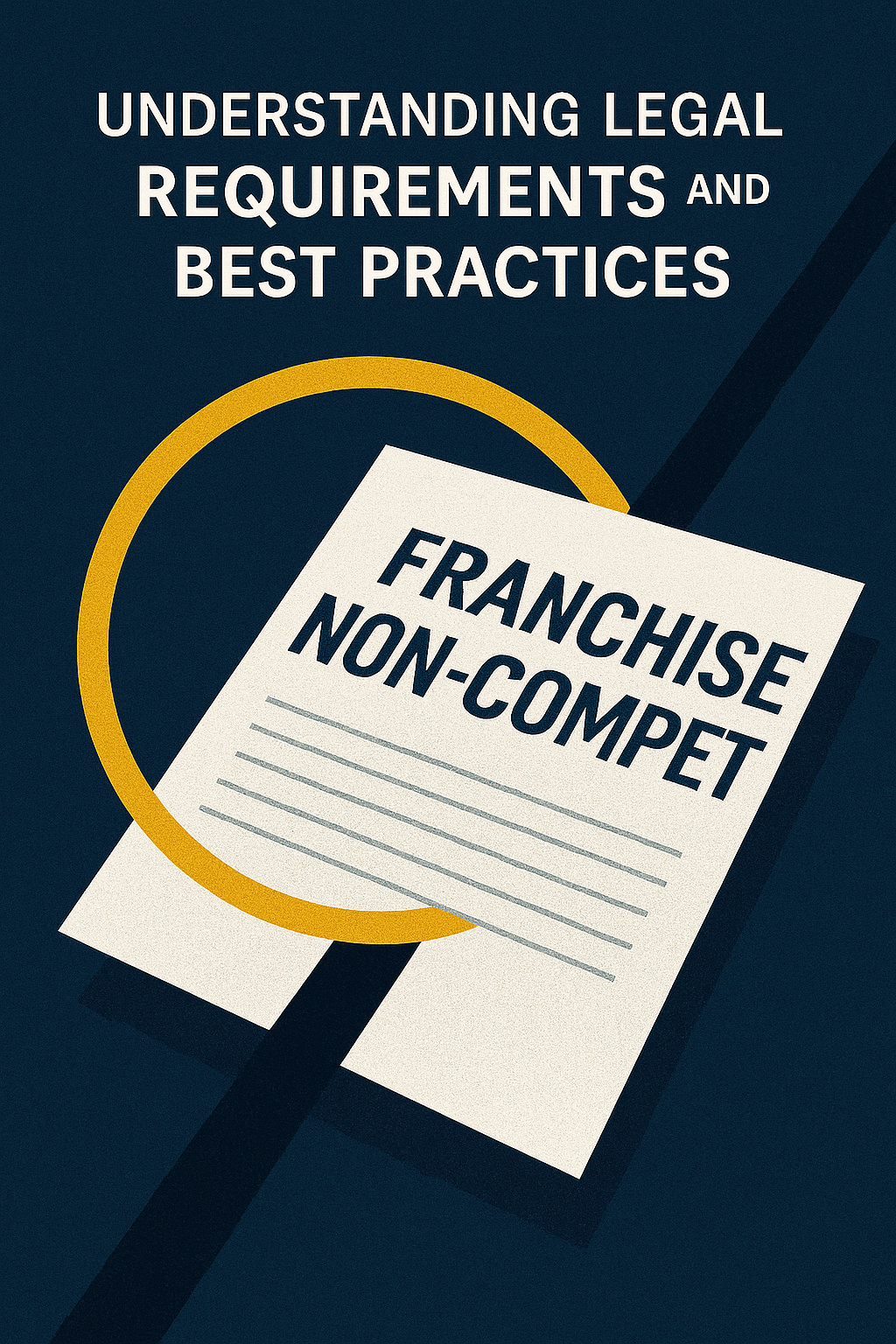Territories in franchise agreements define the operational areas for franchisees, and this clarity is key to their success. Clear boundaries prevent conflicts, ensure fair market opportunities, and protect franchisees’ investments. By outlining exclusive or protected areas, these agreements boost customer loyalty and allow franchisees to concentrate their marketing efforts. This article will discuss the importance of territories in franchise agreements and their various advantages for both franchisors and franchisees.
Key Takeaways
Franchise territories are critical in franchise agreements as they define operational boundaries for franchisees, ensuring market coverage and reducing overlap and conflict among franchisees.
Well-defined franchise territories offer numerous benefits including conflict prevention, enhanced marketing efforts, increased customer reach, and business stability, making them fundamental for the success and growth of franchise networks.
Legal compliance in franchise territory agreements is essential to avoid legal disputes; this includes clear definitions in the Franchise Disclosure Document (FDD) and ensuring boundaries do not violate anti-trust laws.
Defining Franchise Territories

Defined regions where franchisees are permitted to conduct their business activities, known as franchise territories, ensure adequate market penetration and avoid encroaching on the domains of other franchisees. These areas are crucial for safeguarding the investments made by franchisees by giving them exclusive control over a specific local area which helps with enhancing brand recognition and fostering customer loyalty. The delineation of a particular territory for each franchisee constitutes an essential element within any franchise agreement due to its role in offering clear boundaries that minimize disputes between adjacent franchised territories or among fellow operators.
Anyone engaged in the realm of franchising is expected to understand the nuances distinguishing various kinds of territories allocated under these agreements. Exclusive and protected territories represent two fundamental classifications granting varied degrees of protection along with diverse opportunities regarding operational flexibility available both to individuals who manage franchises (franchisees) and those who own rights to the greater network (franchisors).
Exclusive Territory vs. Protected Territory
A franchisee obtains the unique right to conduct business and promote a brand within a certain geographic region when granted an exclusive territory, thereby eliminating any territorial competition from other franchisees. This arrangement affords the franchisee considerable advantages in marketing, as they can concentrate their efforts on cultivating a dedicated local clientele without concern for rivalry from others representing the same brand. Multi-unit operators or area developers often receive such exclusive and protected territories through development agreements that designate them as the predominant providers of the brand’s offerings in their designated market.
In contrast, with protected territories:
Franchisees are provided with clear operating boundaries
Exclusivity is not guaranteed within these areas
They outline specific regions where franchises may be conducted
A degree of healthy competition is maintained along with franchisor flexibility
It opens opportunities for franchisors to establish multiple businesses within overlapping areas
While this model offers less safeguarding for individual franchises
It enables franchisors to optimize revenue by fitting more business outlets into particular locales.
Defined Territory and Its Impact
Franchise agreements hinge on the inclusion of clearly delineated territories, providing franchisees with a specific area to conduct their operations. This demarcation is crucial for preventing territory overlap between franchisees, fostering unity and efficacy within the entire network of franchises. By having set boundaries in place, each franchisee can develop a dedicated customer base within their exclusive region without concern over interference from other members of the same network.
Distinct territorial lines come with an array of advantages that enhance brand loyalty amongst consumers while expanding market presence and improving financial outcomes for both individual franchise owners and the franchisor collectively. With defined areas at hand, every single franchise can pour resources into targeted marketing strategies and nurture solid bonds with clients locally—efforts that are instrumental to amplifying the stature and prosperity across all branches involved in the interconnected web of franchises.
Benefits of Well-Defined Territories

Having well-defined franchise territories brings numerous advantages to a franchise system, including:
Minimizing disputes between franchisees
Reducing internal competition within the brand
Promoting unity across the franchise network
Guaranteeing thorough market penetration
Drawing in high-caliber potential franchisees with assured exclusive markets
Providing fair marketing possibilities for all involved franchises
Avoiding the risk of flooding the market with too many outlets
Assuring that every single franchised business has an equitable shot at prospering
To reap these rewards, careful planning of territory allocation is crucial.
The establishment of clear-cut territories offers key benefits like:
Mitigating conflicts among businesses
Amplifying effectiveness in marketing efforts
Broadening scope and servicing more customers effectively
Contributing to both business growth and stability
It’s clear then why definitive territories are fundamental to any thriving operations within a reputable franchises structure.
Territorial Protection
A franchise agreement typically includes a provision for territorial protection, which prohibits the franchisor from establishing another franchise within a designated area surrounding the business of an existing franchisee. This demarcation ensures that franchisees are not subjected to competition with others operating under the same brand in close proximity. Such security fosters stable growth and reduces concerns about direct, internal market conflict by guaranteeing exclusive territories.
To maintain consistency across all outlets and prevent competitive conflicts, it is crucial for franchises to clearly define their geographic boundaries in their agreements. Franchisees rely on territory rights conferred upon them by the franchisor to carve out a protected segment of the marketplace where they can concentrate on overcoming external commercial challenges instead of worrying about potential intrusion from other entities bearing identical branding within their assigned territories.
Marketing Efforts and Customer Reach

Territorial delineation provides franchisees with the ability to:
Concentrate their marketing resources on specific areas, thus increasing penetration in the local market
Customize their marketing approaches to cater to the distinctive demands of their area’s customers
Conduct more successful advertising and promotional campaigns
Allocate resources more efficiently and target customers more accurately
Such a concentrated strategy results in enhanced resource allocation and refined customer targeting.
Establishing territorial boundaries delivers multiple advantages for businesses operating franchises.
Opportunity to tap into lucrative customer segments
— Increase in marketing effectiveness due primarily to targeted efforts.
— Anticipation of customer behaviors within distinct regions.
Ability allows aligning sales strategies with regional preferences effectively.
— Provision of superior customer service tailored for each territory.
— Amplification of overall performance leading to significant business growth.
Business Growth and Stability
Strategic territory allocation helps in the effective expansion of franchise networks, ensuring brand presence in new markets without oversaturation. By granting exclusive areas, franchisors cultivate an amicable environment among franchisees, enabling them to build stronger customer relationships within their protected market. This sense of security fosters consistent business growth and stability.
Clear territories provide a stable operational environment, supporting franchisee success and system-wide growth. Equitable and fair territories contribute to the stability and profitability of franchises, ensuring that all franchisees have a fair opportunity to thrive. This strategic approach ultimately supports the long-term success and sustainability of the franchise network.
Legal Implications of Franchise Territories

It is imperative that agreements concerning franchise territories adhere to established legal norms in order to avoid legal consequences. Such agreements must not contravene anti-trust legislation aimed at thwarting monopolistic behaviors and promoting equitable competition. It is vital for the legality and vitality of the entire franchise network that these territory agreements steer clear of fostering unfair competition.
Adherence to legal mandates is critically important for all parties within a franchise – franchisors as well as franchisees. Crafting a comprehensive franchise agreement, one which unambiguously delineates the boundaries and entitlements pertaining to territory, can prevent litigation issues while facilitating a harmonious relationship between franchisor and franchisee.
Franchise Disclosure Document (FDD) Requirements
The Franchise Disclosure Document (FDD) is essential for detailing the rights and restrictions pertaining to a franchisee’s territory. This document must clearly communicate any limitations or exclusions associated with these rights, ensuring that both the franchisor and the franchisee have mutual understanding regarding the demarcation of territories. Item 12 in particular requires this information about whether an exclusive or protected territory is provided.
Within the FDD, it is imperative for franchisors to define both the dimensions and confines of an assigned franchise territory explicitly. It should spell out any specific terms under which a franchisee may be permitted to move their business operations. Should there be exclusive territories granted, all conditions requisite for upholding such exclusivity need to be articulated within this document.
For those franchises operating within non-exclusive territories, disclosures made in the FDD must make clear that competition could emerge from other sources—emphasizing potential market challenges faced by franchisees due to non-exclusivity provisions.
Potential Legal Disputes
Legal disputes often arise from the vagueness in the definition of franchise territories, leading to overlaps. When franchisors and franchisees have conflicting interpretations of territory boundaries, it can result in significant legal challenges. Encroachment by neighboring franchisees or the introduction of new competing franchises within a territory can lead to legal conflicts.
Overlapping territories can also spark legal disputes between franchisees in close proximity. To avoid such problems, franchise agreements must feature explicit and exact territory definitions, ensuring all parties comprehend their rights and limitations within the same territory.
Mapping Franchise Territories

The process of mapping franchise territories includes collecting pertinent information, illustrating demographic data, and applying boundary tools to delineate territories using established geographical borders. The use of heatmaps and advanced territory mapping software has improved the visualization and management capabilities for franchises, rendering franchise territory mapping a crucial component in strategizing.
During the formulation of a franchise’s territory map, it is important to input critical location-based information—such as locations of current stores, competitors’ stores, and customer distribution—to pinpoint areas that demonstrate strong potential demand. Boundary tools facilitate setting up sales regions consistent with recognized geographic divisions like zip codes or political boundaries such as counties or states. By adopting this structured method for establishing franchises’ territories, they are clearly specified and in harmony with the overarching objectives of the business.
Using Demographic Data
Demographic data includes customer lifestyle preferences, which helps in understanding where potential customers spend most of their time. Demographic mapping includes data points such as population, age, income, education, and labor, which are crucial for understanding customer bases. Visualizing demographic data using thematic mapping can help identify suitable franchise territories by showing population and income levels at different geographical units.
Population density analysis is crucial in determining the size and boundaries of franchise territories; denser populations may support larger zones. In-depth demographic analysis and market research play a significant role in delineating franchise territories that are fair, profitable, and sustainable. Analyzing competitor density within each possible area can pinpoint regions ripe for entry while recognizing potential hurdles.
Aligning Territories with Business Goals
Strategically dividing territory enables the targeted allocation of resources, concentrating efforts in areas with significant potential. This demarcation facilitates sustained strategic planning and investment by establishing explicit market divisions. By balancing lucrative territories with those that are less developed, a company can foster widespread business growth.
Typically, combining demographic insights and geographic exclusivity is key to crafting effective territorial strategies that boost franchisee performance while minimizing disputes. Continuously reviewing and adjusting the boundaries of these territories allows franchisors to reshape them in line with evolving business requirements.
Case Studies: Successful Franchise Territory Strategies
Examining real-world scenarios offers practical lessons and showcases best practices in managing franchise territories. By analysing demographic information, franchises develop strategies for carving out optimal territories.
These case studies are instrumental in understanding how successful business franchises strike a balance between growth and quality control by employing effective territory development tactics. The insights gained from such cases shed light on the implementation of efficient territory strategies that drive franchise success.
Example 1: Service-Based Franchise
Franchises that are service-oriented tend to prioritize local service excellence and the convenience of their customers when delineating their territories. By incorporating customer insights, a franchise centered on services can fine-tune its territorial limits. For example, a home repair franchise might establish its territories with consideration to variables such as population density and average household earnings to guarantee each franchisee obtains an equitable assortment of both residential and business clients.
Adopting this method guarantees that franchisees have the capability to deliver superior, localized assistance tailored to the particular demands of their clients, thereby boosting consumer contentment and fostering brand loyalty.
Example 2: Brick-and-Mortar Franchise
Typically, a brick-and-mortar franchise is granted exclusivity over a designated territory that encompasses a certain radius from its physical location. The goal of this policy is to diminish intra-brand competition while augmenting the potential for customer visits. Ensuring that each storefront maintains an adequate market area through distinct territorial limits enables every unit within the franchise to sustain and flourish.
Adopting such calculated measures in store placement and territorial demarcation not only bolsters the financial well-being of independent franchises, but also plays a crucial role in reinforcing the collective robustness and growth of the entire franchise network.
Common Challenges in Defining Franchise Territories
It is crucial for franchisors to maintain a vigilant eye on the management of franchise territories, ensuring they remain efficient. To manage these territories effectively, it is essential to:
Keep abreast of and respond to changes in market dynamics and competition.
Take into account fluctuations in population density.
Oversee franchises that border each other.
Modify the size or scope ass necessary over time.
Such proactive strategies enable franchisors to uphold a competitive edge and profitability within their franchise network for both existing franchisees as well as those who are considering joining the venture.
Addressing Population Density Variations
The process of defining territories must be carefully aligned with the objectives of a business, taking into consideration factors like population density, income brackets, and the proximity of competitors to carve out market areas that tap into their fullest potential. Territories in densely populated regions can support bigger franchise zones due to a more substantial base of potential customers. Conversely, sparser areas may require smaller dedicated spaces so every franchisee has enough customer access.
In establishing these territories for franchises, it’s crucial to conduct an in-depth examination of demographic data while considering disparities in population density. By doing this meticulous planning exercise, each designated territory holds the capacity for profitability and longevity irrespective of varying levels of density within the populations they serve.
Managing Adjacent Territories
It is imperative for franchisors to delineate territory rights and boundaries with precision in their contracts, thus averting potential disagreements. Establishing well-defined geographic demarcations helps avert complications that arise from encroachment between neighboring franchise territories. Strategic partitioning of the region is essential to maximize the profitability of each franchisee while preventing territorial overlaps.
To manage adjacent territories effectively, it’s vital to establish clear expectations and foster consistent dialogue among franchisees. By doing so, every member within the network comprehends their respective duties and entitlements, which diminishes conflict likelihood and bolsters the prosperity of the entire franchise system.
Adjusting Territories Over Time
To accommodate changing market dynamics and the scaling of their business, franchisors should periodically reconsider and adjust the boundaries of their franchise territories. The adaptation of these territories is critical to facilitate ongoing business growth, necessitating current data due to frequent changes in demographics and economic environments.
Proactive oversight and adjustment of franchise territory allocations enable franchisors to guarantee equitable expansion prospects within their network. Aligning each territory with present-day commercial necessities affords every franchisee a reasonable opportunity for success while maintaining a competitive edge and profitability across the entire franchise network.
Summary
In conclusion, well-defined franchise territories are essential for the success and stability of any franchise network. They prevent conflicts, enhance marketing efforts, support business growth, and ensure legal compliance. By understanding the different types of territories, their benefits, and the legal implications, franchisors and franchisees can create a thriving and cohesive franchise network.
As you embark on your franchising journey, remember that strategic territory planning and continuous management are key to long-term success. By staying informed and proactive, you can navigate the complexities of franchise territory management and achieve your business goals.
Frequently Asked Questions
What is the difference between an exclusive territory and a protected territory?
A franchisee is granted the sole right to operate within a specified area with an exclusive territory, whereas a protected territory delineates boundaries but does not assure exclusivity. Hence, the main distinction hinges on the degree of exclusivity bestowed upon the franchisee in their territory.
Why are well-defined territories important in franchise agreements?
In franchise agreements, having clear territories is crucial as it aids in avoiding disputes, bolsters marketing initiatives, fosters the expansion of the business and guarantees thorough market penetration. These elements collectively contribute to the prosperity and triumph of a franchise.
What should be included in a Franchise Disclosure Document (FDD) regarding territories?
It is crucial for the Franchise Disclosure Document (FDD) to provide comprehensive information regarding the rights, restrictions, and specifics related to the franchisee’s territory. This includes data on the scope, demarcations, exclusions, as well as terms for preserving territorial exclusivity or conditions under which relocation of the business is permissible—all key elements in grasping the territorial provisions stipulated by a franchise agreement.
How can demographic data be used in mapping franchise territories?
Utilizing demographic data, businesses can refine their marketing strategies and customize their customer base approach. Such information is crucial for defining the dimensions and limits of franchise territories by considering aspects like population density. This intelligence proves to be instrumental in planning the strategic growth of a franchise.
What are some common challenges in defining franchise territories?
Managing franchise territories requires careful consideration due to the differing population density, the handling of neighboring territories, and adapting these areas to suit market conditions and business requirements.
When planning for successful business operations within a franchise system, it is crucial to take into account these elements as you define your franchise territories.







